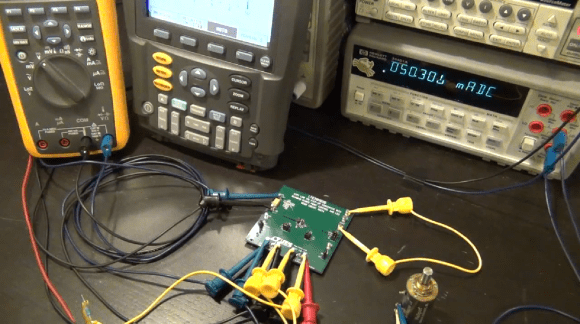
[Shahriar] devoted the lastest episode of The Signal Path to looking at energy harvesting chips. These parts are designed to gather energy from non-traditional sources as efficiently as possible. The full episode, which is embedded after the break, is about one hour long. It starts with a bit of background about the nature of these parts, and a brief overview of the wide-range of chips available. Each is suited for a different type of energy source.
He moves on to test and explain the LTC3105 and the LTC3109. The former is shown above on a development board. [Shahriar] hooks it up to his bench equipment to compare its performance to the published specs. This culminates in a circuit that uses a solar cell as the source with a super capacitor used as storage. The latter is connected to a Peltier cooler and used to convert the potential energy of ice cubes to electrical energy which charges his iPhone for about thirty seconds. This might be useful in that Peltier generator we saw last week.














A lot of problems with these is that they will not do a WIDE voltage swing. I have a 15 watt solar panel that would generate useable power until dark if one ofthese chips was used for the low light part, but when in full sunlight they pop like an ant under a magnifying glass. I have a 250mv-9V swing on the flexible solar panel. Yes I will not get 15 watts at 250mv but I am getting something that could be stored if the circuit could step it up.
What is needed is one of these systems that can take a 250mv to 20V swing and regulate to 5.1V at 90% efficiency for battery charging. even getting 0.05A charge rate from a solar panel in low light is more energy.
well, that’s not really their intended purpose. wide swing voltage regulators are pretty hard to build, but not impossible.
The 3105 maxes at 400mA input, so 15W is out of the question. Linear, TI, ST, Maxim… they all make MPPT charging ICs. You can check their product lines to see if one fits your needs.
I agree with andres, that is not what these parts are intended for. The LTC3109 is for thermoelectric generators and other voltage sources as low as 30 mV. It’s also important to note that the LTC3109 is most efficient for input voltages of about 100 mV (depending on the transformer ratio). The efficiency drops to about 5% for input voltages of about 1 V, so this part isn’t really meant for a wide input range. The LTC3105 is a little more flexible in this regard, although it is most efficient at about 2.5 volts dropping to about 50% efficiency at approximately 5 volts.
single solar cell voltage is 0.6 V.
Or limit max voltage to ca 0.6 V using a diode across the panel.
the demo board is US$150 ..even the ic is just $3 . .
why the demo board is so expensive…
My website offers a LTC3108 breakout for $29.95. The LTC3108 is similar to the LTC3109, but doesn’t have the auto-polarity feature.
website url pls?
http://www.crispytronics.com/products/1
It is possible to order demo sample and solder on breakout board yourself using thin enamel wire. Where to order transformer?
I sucessfuly use LTC3105, see pdf file here:
http://www.instructables.com/id/GSM-Android-phone-as-HD-outdoor-webcam/
Hello I was wondering about LTC3108, in the datasheet it says that the IC starts operating at 20mV but doesn’t say how high can it go. How much voltage can it withstand ? What if the TEG is giving >>1V will the IC still operates?? Please let me know.
Hi Milan, that’s a great question. You can find the answer on page 12 of the datasheet:
For a given transformer turns ratio, there is a maximum recommended input voltage to avoid excessively high secondary voltages and power dissipation in the shunt regulator. It is recommended that the maximum input voltage times the turns ratio be less than 50.
For example, for a startup voltage of 20 mV a 1:100 transformer is used. Therefore, the maximum input voltage would be 50 V / 100 = 0.5 V. I sell two versions of a LTC3108 breakout board: one with a 1:100 transformer and another with a 1:20 transformer (2.5 V max).
http://www.crispytronics.com/products/1
http://www.crispytronics.com/products/2
Hello Crispytronics,
thanks for the reply and just read the datasheet, so it means that if I use the transformer ration of 1:10 than i can have V input max= (50*1/(10)) = 5V , can I use this for maximum input? So if I understood correctly and if I am using this turn ratio (1:10) then it will not work at min input voltage like 20mV right because the output of the transformer will only be like 20mV*10 = 200mV?
Can I use this transformer ratio for increasing my Vin max? or even use 1:5 turn ratio to get Vin max of 10V?
Excellent demo covering the capabilities of the IC’s as well as an interesting application. Very well done.
I am now selling a breakout board for the LTC3105 in addition to the LTC3108. The LTC3108 is similar to the LTC3109, but does not have auto-polarity.
Weird, it works for me. Thanks for letting me know though!
Abandoned Shop?
> $29.95 / Sold Out / Currently out of stock, more coming on December 17th, 2016